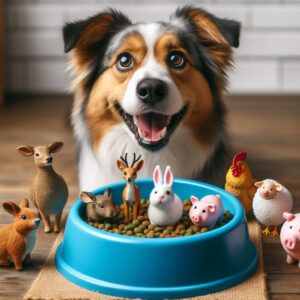Feeding raw and fresh food to dogs
Dogs are carnivores ( and omnivores) and need a varied diet to support a long and healthy life. Just like us they are curious and enjoy variation and new experiences.
Always monitor your dog when they are eating. NEVER take the food away from your dog when they eat, this may lead to resource guarding. Make sure that the bowls are placed in such a way that the dog is comfortable standing and eating. Vary the height until you find the height that your dogs seems the most comfortable with. Make sure the dog can stand on a non-slip surface while eating.
Make sure your dog isn't hungry when you're doing learning activities with them. Hungry dog = zero concentration and often increased frustration. To feed a dog its meals from a slow feeder or a LickyMat can increase frustration, especially in puppies and adolescent dogs, but also in adult dogs.
How to easily feed raw and fresh food to your dog
- Meat, fish, vegetables are good. Small amounts of eggs and some grains are okay.
- Feed Meat , chicken, turkey, pork (pork needs cooking).
- Game and beef in variation can be cooked and made into minced meat.
- All Innards are good for your dog - and cheaper too!
- Boiled fish of all kinds and boiled veggies
- Vegetables should not make up more than 10% of a meal - you can feed broccoli, spinach, carrot, sweet potatoes,
seaweed, beans, pumpkin, blueberries - you can blend the vegetables into a pure and add some spices and herbs ( I add a little
bit of meat fond that I get from cooking out the frying pan with
water after I cook some meat. Add it to the purèe to make it extra interesting - you can keep a batch of purèe in the fridge for a few days, or even put it in the freezer if you make a bigger batch. - Cooked eggs a few times a week (in some countries like Norway it can be served raw since there's no Salmonella in the eggs). Egg whites are best digested when they are cooked.
- Feed little or no grains to your dog, just a few crumbles or leftovers from your own food.
Put all the ingredients in your dogs bowl and feed 2-3 times a day as follows:
Puppies: 3 times a day
Adults = 1-2 times a day
How much food does your dog need?
Puppies: up to 10% of their bodyweight a day reduce slowly as
they grow older
Adult dog: ca 1,5 - 2,5 % of their bodyweight a day
Add some nuts and seeds and herbs if you like - be sure to check first - as some nuts are poisonous to dogs!
You can add some spices for flavour - I like to add a little bit of turmeric to the meat and fish when I cook
meat for my dog, it's great for joint health and also helps reduce inflammation (for humans
as well).
The key is variation - add cartilage and bone like chicken feet, duck neck,
ox tail (for bigger dogs), rabbit ears (with fur if you can) - for small dogs, chicken
neck and feet, and rabbit ears, are an appropriate size. For big dogs - make sure you don't have a dog
that gobbles things, or eats inedible objects that can be unsafe. and no antlers! Ever!
How to feed raw bones to a dog:
https://dogsfirst.ie/raw-faq/how-to-feed-a-dog-bones/
